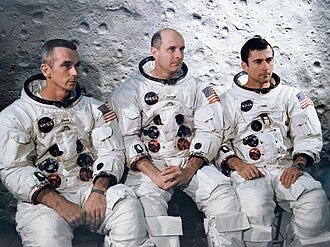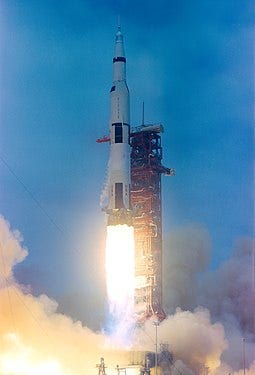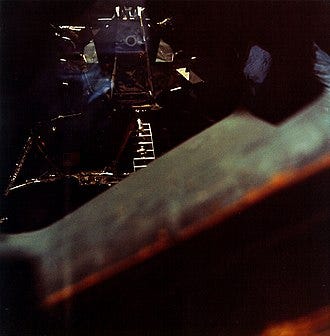May 18, 1969 12:39pm
Crew: Thomas Stafford, John Young, Gene Cernan
Duration: 8 days, 3 minutes, 23 seconds
When the Apollo 10 mission was first planned, the Lunar Module would only be tested in the same way Apollo 9 had tested. It would be retrieved, and the crew would perform rendezvous and docking tests. But six months before it's scheduled launch, mission planners convinced NASA administrators to go farther. They agreed to fly the LM down, close to the surface, to check out the landing radar. Preparations for the flight were complicated by the Apollo 9 launch but didn’t delay Apollo 10.
Command Tom Stafford and his crew, Command Module Pilot John Young and Lunar Module Pilot Gene Cernan, chose the names Charlie Brown for the CSM and Snoopy for the LM. All three were veterans of space flight.
The Saturn V was rolled out to Launch Complex 39B and on May 18th, 1969, the rocket was launched.
Once in orbit, all of the spacecraft systems were tested before the third stage S-IVB was re-ignited for the trans-lunar injection burn. Safely on the way to the moon, the S-IVB was jettisoned, and Young proceeded to extract Snoopy.
After reaching lunar orbit, Stafford and Cernan boarded Snoopy, leaving Young behind in Charlie Brown. They fired the descent engine and began their approach. At 50,000 feet above the surface, the landing radar went to work. This was the altitude the real descent to the surface would begin. They surveyed the Apollo 11 landing site in the Sea of Tranquility.
Trouble reared up when they jettisoned the LM Descent stage and fired the ascent engine. Snoopy began rolling violently. The crew had accidentally put the flight computer in the wrong mode. Cernan said the lunar module rolled over eight times. Stafford and Cernan got the LM under control again, but it had been an extremely dangerous situation.
After docking safely and transferring to the CSM, Snoopy was jettisoned. NASA fired up its ascent engine again remotely, sending Snoopy into orbit around the Sun. It remains there today, the only formerly manned spacecraft still in space without a crew.
Charlie Brown splashed down safely on May 26th of the east coast of American Samoa in the Pacific Ocean.
Charlie Brown can be seen at the London Science Museum.
After thirty-one orbits, the SPS was fired up and kicked Charlie Brown back to Earth. On the way home, Charlie Brown set a speed record that stands to this day, traveling at a speed of 24,791 miles per hour. Re-entry and splashdown in the Pacific were uneventful. The dress rehearsal was complete.







'On the way home, Charlie Brown set a speed record that stands to this day, traveling at a speed of 24,791 miles per hour'!!! this is the stuff i enjoy learning, as well as following the suspense...